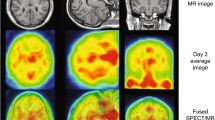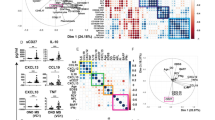Abstract
Background
The pathophysiology of multiple sclerosis involves an autoimmune and a neurodegenerative mechanism. Central nervous system-infiltrating immune cells in multiple sclerosis also possess a neuroprotective activity through secretion of neurotrophins, such as brain-derived neurotrophic factor. Fingolimod was shown to slow the progression of disability and loss of brain volume.
Objective
The objective of this study was to explore whether fingolimod induces secretion of neurotrophins by immune cells.
Methods
Blood was drawn from 21 patients before the initiation of treatment with fingolimod and at 6 and 12 months of follow-up. The levels of the neurotrophic factors brain-derived neurotrophic factor, glial cell-derived neurotrophic factor, β-nerve growth factor, neurotrophin-3, neurotrophin-4, basic fibroblast growth factor, epidermal growth factor, and vascular endothelial growth factor were screened in the supernatants of separated T cells and monocyte cultures using a customized, multiplex enzyme-linked immunosorbent assay. Brain-derived neurotrophic factor levels were further validated by a specific enzyme-linked immunosorbent assay.
Results
Treatment with fingolimod significantly increased brain-derived neurotrophic factor secretion from T cells. A specific enzyme-linked immunosorbent assay confirmed these results in the supernatant of T cells after 6 and 12 months of therapy.
Conclusions
T cells that reach the bloodstream of fingolimod-treated patients with multiple sclerosis may contribute to the neuroprotective effect of this therapy by increased secretion of brain-derived neurotrophic factor. This mechanism of action of fingolimod in patients with multiple sclerosis has not been previously reported.




Similar content being viewed by others
References
Barnett MH, Prineas JW. Relapsing and remitting multiple sclerosis: pathology of the newly forming lesion. Ann Neurol. 2004;55:458–68.
Lucchinetti C, Bruck W, Parisi J, Scheithauer B, Rodriguez M, Lassmann H. A quantitative analysis of oligodendrocytes in multiple sclerosis lesions: a study of 113 cases. Brain. 1999;122(Pt 12):2279–95.
Bjartmar C, Trapp BD. Axonal and neuronal degeneration in multiple sclerosis: mechanisms and functional consequences. Curr Opin Neurol. 2001;14:271–8.
Linker R, Gold R, Luhder F. Function of neurotrophic factors beyond the nervous system: inflammation and autoimmune demyelination. Crit Rev Immunol. 2009;29:43–68.
De Santi L, Polimeni G, Cuzzocrea S, Esposito E, Sessa E, Annunziata P, et al. Neuroinflammation and neuroprotection: an update on (future) neurotrophin-related strategies in multiple sclerosis treatment. Curr Med Chem. 2011;18:1775–84.
Popova NK, Ilchibaeva TV, Naumenko VS. Neurotrophic factors (BDNF and GDNF) and the serotonergic system of the brain. Biochemistry (Mosc). 2017;82:308–17.
Poyhonen S, Er S, Domanskyi A, Airavaara M. Effects of neurotrophic factors in glial cells in the central nervous system: expression and properties in neurodegeneration and injury. Front Physiol. 2019;10:486.
Binder DK, Scharfman HE. Brain-derived neurotrophic factor. Growth Factors. 2004;22:123–31.
Vondran MW, Clinton-Luke P, Honeywell JZ, Dreyfus CF. BDNF +/− mice exhibit deficits in oligodendrocyte lineage cells of the basal forebrain. Glia. 2010;58:848–56.
Xiao J, Wong AW, Willingham MM, van den Buuse M, Kilpatrick TJ, Murray SS. Brain-derived neurotrophic factor promotes central nervous system myelination via a direct effect upon oligodendrocytes. Neurosignals. 2010;18:186–202.
Peckham H, Giuffrida L, Wood R, Gonsalvez D, Ferner A, Kilpatrick TJ, et al. Fyn is an intermediate kinase that BDNF utilizes to promote oligodendrocyte myelination. Glia. 2016;64:255–69.
Fletcher JL, Murray SS, Xiao J. Brain-derived neurotrophic factor in central nervous system myelination: a new mechanism to promote myelin plasticity and repair. Int J Mol Sci. 2018. https://doi.org/10.3390/ijms19124131.
Hofer MM, Barde YA. Brain-derived neurotrophic factor prevents neuronal death in vivo. Nature. 1988;331:261–2.
Burbach GJ, Hellweg R, Haas CA, Del Turco D, Deicke U, Abramowski D, et al. Induction of brain-derived neurotrophic factor in plaque-associated glial cells of aged APP23 transgenic mice. J Neurosci. 2004;24:2421–30.
Stadelmann C, Kerschensteiner M, Misgeld T, Bruck W, Hohlfeld R, Lassmann H. BDNF and gp145trkB in multiple sclerosis brain lesions: neuroprotective interactions between immune and neuronal cells? Brain. 2002;125:75–85.
Kerschensteiner M, Gallmeier E, Behrens L, Leal VV, Misgeld T, Klinkert WE, et al. Activated human T cells, B cells, and monocytes produce brain-derived neurotrophic factor in vitro and in inflammatory brain lesions: a neuroprotective role of inflammation? J Exp Med. 1999;189:865–70.
Klein AB, Williamson R, Santini MA, Clemmensen C, Ettrup A, Rios M, et al. Blood BDNF concentrations reflect brain-tissue BDNF levels across species. Int J Neuropsychopharmacol. 2011;14:347–53.
Azoulay D, Urshansky N, Karni A. Low and dysregulated BDNF secretion from immune cells of MS patients is related to reduced neuroprotection. J Neuroimmunol. 2008;195:186–93.
Azoulay D, Vachapova V, Shihman B, Miler A, Karni A. Lower brain-derived neurotrophic factor in serum of relapsing remitting MS: reversal by glatiramer acetate. J Neuroimmunol. 2005;167:215–8.
Mehrpour M, Akhoundi FH, Delgosha M, Keyvani H, Motamed MR, Sheibani B, et al. Increased serum brain-derived neurotrophic factor in multiple sclerosis patients on interferon-beta and its impact on functional abilities. Neurologist. 2015;20:57–60.
Urshansky N, Mausner-Fainberg K, Auriel E, Regev K, Farhum F, Karni A. Dysregulated neurotrophin mRNA production by immune cells of patients with relapsing remitting multiple sclerosis. J Neurol Sci. 2010;295:31–7.
Brinkmann V, Billich A, Baumruker T, Heining P, Schmouder R, Francis G, et al. Fingolimod (FTY720): discovery and development of an oral drug to treat multiple sclerosis. Nat Rev Drug Discov. 2010;9:883–97.
Ingwersen J, Aktas O, Kuery P, Kieseier B, Boyko A, Hartung H-P. Fingolimod in multiple sclerosis: mechanisms of action and clinical efficacy. Clin Immunol. 2012;142:15–24.
Gonzalez-Cabrera PJ, Cahalan SM, Nguyen N, Sarkisyan G, Leaf NB, Cameron MD, et al. S1P(1) receptor modulation with cyclical recovery from lymphopenia ameliorates mouse model of multiple sclerosis. Mol Pharmacol. 2012;81:166–74.
Matsumoto N, Hirose R, Sasaki S, Fujita T. Synthesis of the key intermediate, diethyl 2-acetylamino-2-(2-(4-octanoylphenyl)ethyl)propane-1,3-dioate, of the immunomodulatory agent FTY720 (fingolimod). Chem Pharm Bull (Tokyo). 2008;56:595–7.
Balatoni B, Storch MK, Swoboda E-M, Schonborn V, Koziel A, Lambrou GN, et al. FTY720 sustains and restores neuronal function in the DA rat model of MOG-induced experimental autoimmune encephalomyelitis. Brain Res Bull. 2007;74:307–16.
Deogracias R, Yazdani M, Dekkers MPJ, Guy J, Ionescu MCS, Vogt KE, et al. Fingolimod, a sphingosine-1 phosphate receptor modulator, increases BDNF levels and improves symptoms of a mouse model of Rett syndrome. Proc Natl Acad Sci U S A. 2012;109:14230–5.
Hoffmann FS, Hofereiter J, Rubsamen H, Melms J, Schwarz S, Faber H, et al. Fingolimod induces neuroprotective factors in human astrocytes. J Neuroinflammation. 2015;12:184.
Noda H, Takeuchi H, Mizuno T, Suzumura A. Fingolimod phosphate promotes the neuroprotective effects of microglia. J Neuroimmunol. 2013;256:13–8.
Barkhof F, de Jong R, Sfikas N, de Vera A, Francis G, Cohen J. The influence of patient demographics, disease characteristics and treatment on brain volume loss in Trial Assessing Injectable Interferon vs FTY720 Oral in Relapsing-Remitting Multiple Sclerosis (TRANSFORMS), a phase 3 study of fingolimod in multiple scl. Mult Scler. 2014;20:1704–13.
Calabresi PA, Radue E-W, Goodin D, Jeffery D, Rammohan KW, Reder AT, et al. Safety and efficacy of fingolimod in patients with relapsing-remitting multiple sclerosis (FREEDOMS II): a double-blind, randomised, placebo-controlled, phase 3 trial. Lancet Neurol. 2014;13:545–56.
Kappos L, Radue E-W, O’Connor P, Polman C, Hohlfeld R, Calabresi P, et al. A placebo-controlled trial of oral fingolimod in relapsing multiple sclerosis. N Engl J Med. 2010;362:387–401.
Cohen JA, Chun J. Mechanisms of fingolimod’s efficacy and adverse effects in multiple sclerosis. Ann Neurol. 2011;69:759–77.
De Stefano N, Silva DG, Barnett MH. Effect of fingolimod on brain volume loss in patients with multiple sclerosis. CNS Drugs. 2017;31:289–305.
Cree BAC, Hollenbach JA, Bove R, Kirkish G, Sacco S, Caverzasi E, et al. Silent progression in disease activity-free relapsing multiple sclerosis. Ann Neurol. 2019;85:653–66.
Smith PA, Schmid C, Zurbruegg S, Jivkov M, Doelemeyer A, Theil D, et al. Fingolimod inhibits brain atrophy and promotes brain-derived neurotrophic factor in an animal model of multiple sclerosis. J Neuroimmunol. 2018;318:103–13.
Efstathopoulos P, Kourgiantaki A, Karali K, Sidiropoulou K, Margioris AN, Gravanis A, et al. Fingolimod induces neurogenesis in adult mouse hippocampus and improves contextual fear memory. Transl Psychiatry. 2015;5:e685.
Dominguez-Villar M, Raddassi K, Danielsen AC, Guarnaccia J, Hafler DA. Fingolimod modulates T cell phenotype and regulatory T cell plasticity in vivo. J Autoimmun. 2019;96:40–9.
Sun Y, Wang W, Shan B, Di J, Chen L, Ren L, et al. FTY720-induced conversion of conventional Foxp3− CD4+ T cells to Foxp3+ regulatory T cells in NOD mice. Am J Reprod Immunol. 2011;66:349–62.
Aharoni R, Eilam R, Domev H, Labunskay G, Sela M, Arnon R. The immunomodulator glatiramer acetate augments the expression of neurotrophic factors in brains of experimental autoimmune encephalomyelitis mice. Proc Natl Acad Sci U S A. 2005;102:19045–50.
Arnon R, Aharoni R. Mechanism of action of glatiramer acetate in multiple sclerosis and its potential for the development of new applications. Proc Natl Acad Sci USA. 2004;101(Suppl. 2):14593–8.
Noronha A, Toscas A, Jensen MA. Interferon beta decreases T cell activation and interferon gamma production in multiple sclerosis. J Neuroimmunol. 1993;46:145–53.
Calabrese F, Rossetti AC, Racagni G, Gass P, Riva MA, Molteni R. Brain-derived neurotrophic factor: a bridge between inflammation and neuroplasticity. Front Cell Neurosci. 2014;8:430. https://doi.org/10.3389/fncel.2014.00430.
Lewin GR, Barde YA. Physiology of the neurotrophins. Annu Rev Neurosci. 1996;19:289–317.
Acknowledgements
We thank Esther Eshkol, institutional medical copy editor of Tel Aviv Sourasky Medical Center, for assistance in drafting the manuscript.
Author information
Authors and Affiliations
Corresponding author
Ethics declarations
Funding
Novartis AG partially supported the study.
Conflict of interest
Maya Golan, Karin Mausner-Fainberg, Bassima Ibrahim, Moshe Benhamou, Adi Wilf-Yarkoni, Hadar Kolb, Keren Regev, and Arnon Karni have no conflicts of interest that are directly relevant to the content of this study.
Ethics Approval
The study was approved by the local institutional review board in Helsinki (Research No. 0584-13-TLV).
Consent to Participate
All the participants in the study signed an informed consent form upon enrollment.
Rights and permissions
About this article
Cite this article
Golan, M., Mausner-Fainberg, K., Ibrahim, B. et al. Fingolimod Increases Brain-Derived Neurotrophic Factor Level Secretion from Circulating T Cells of Patients with Multiple Sclerosis. CNS Drugs 33, 1229–1237 (2019). https://doi.org/10.1007/s40263-019-00675-7
Published:
Issue Date:
DOI: https://doi.org/10.1007/s40263-019-00675-7




